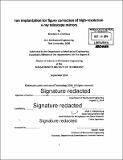| dc.contributor.advisor | Mark L Schattenburg. | en_US |
| dc.contributor.author | Chalifoux, Brandon D | en_US |
| dc.contributor.other | Massachusetts Institute of Technology. Department of Mechanical Engineering. | en_US |
| dc.date.accessioned | 2015-02-25T17:14:04Z | |
| dc.date.available | 2015-02-25T17:14:04Z | |
| dc.date.copyright | 2014 | en_US |
| dc.date.issued | 2014 | en_US |
| dc.identifier.uri | http://hdl.handle.net/1721.1/95614 | |
| dc.description | Thesis: S.M., Massachusetts Institute of Technology, Department of Mechanical Engineering, 2014. | en_US |
| dc.description | Cataloged from PDF version of thesis. | en_US |
| dc.description | Includes bibliographical references (pages 99-103). | en_US |
| dc.description.abstract | Fabricating mirrors for future high-resolution, large-aperture x-ray telescopes continues to challenge the x-ray astronomy instrumentation community. Building a large-aperture telescope requires thin, lightweight mirrors; due to the very low stiffness of thin mirrors, these are difficult to fabricate, coat, and mount, while achieving and maintaining the required surface figure accuracy. Ion implantation offers a potential solution for fabricating high-accuracy mirrors, by providing capability for fine figure correction of mirror substrates. Ion implantation causes local sub-surface stress that is a function of ion fluence, which results in changes in curvature. In principle, implanting to cause the right amount of stress in the right locations on a substrate would allow correction of figure errors in the substrate. In addition, x-ray telescope mirrors must be mechanically stable over decades, and have low surface roughness. In this work, high-energy (150 keV - 1.5 MeV) ions were implanted into silicon and glass substrates, and the implications on figure correction, surface roughness, and surface figure stability studied. Changes in curvature resulting from sub-surface stress were measured, to understand the magnitude of stress that can be applied, and the dependence of stress on ion fluence. Figure corrections of flat silicon substrates were made. To investigate effects on surface roughness, x-ray reflectivity studies were conducted on implanted samples. Stability in surface figure was studied using thermal cycling, and measurements after 1 year of storage. Finally, simulations were conducted for correction of conical substrates similar to what would be used in future x-ray observatories. The results presented in this work suggest that ion implantation is indeed a feasible method of figure correction of mirrors for high-resolution, large-aperture x-ray telescopes. | en_US |
| dc.description.statementofresponsibility | by Brandon D. Chalifoux. | en_US |
| dc.format.extent | 102 pages | en_US |
| dc.language.iso | eng | en_US |
| dc.publisher | Massachusetts Institute of Technology | en_US |
| dc.rights | M.I.T. theses are protected by copyright. They may be viewed from this source for any purpose, but reproduction or distribution in any format is prohibited without written permission. See provided URL for inquiries about permission. | en_US |
| dc.rights.uri | http://dspace.mit.edu/handle/1721.1/7582 | en_US |
| dc.subject | Mechanical Engineering. | en_US |
| dc.title | Ion implantation for figure correction of high-resolution x-ray telescope mirrors | en_US |
| dc.type | Thesis | en_US |
| dc.description.degree | S.M. | en_US |
| dc.contributor.department | Massachusetts Institute of Technology. Department of Mechanical Engineering | |
| dc.identifier.oclc | 903905404 | en_US |
